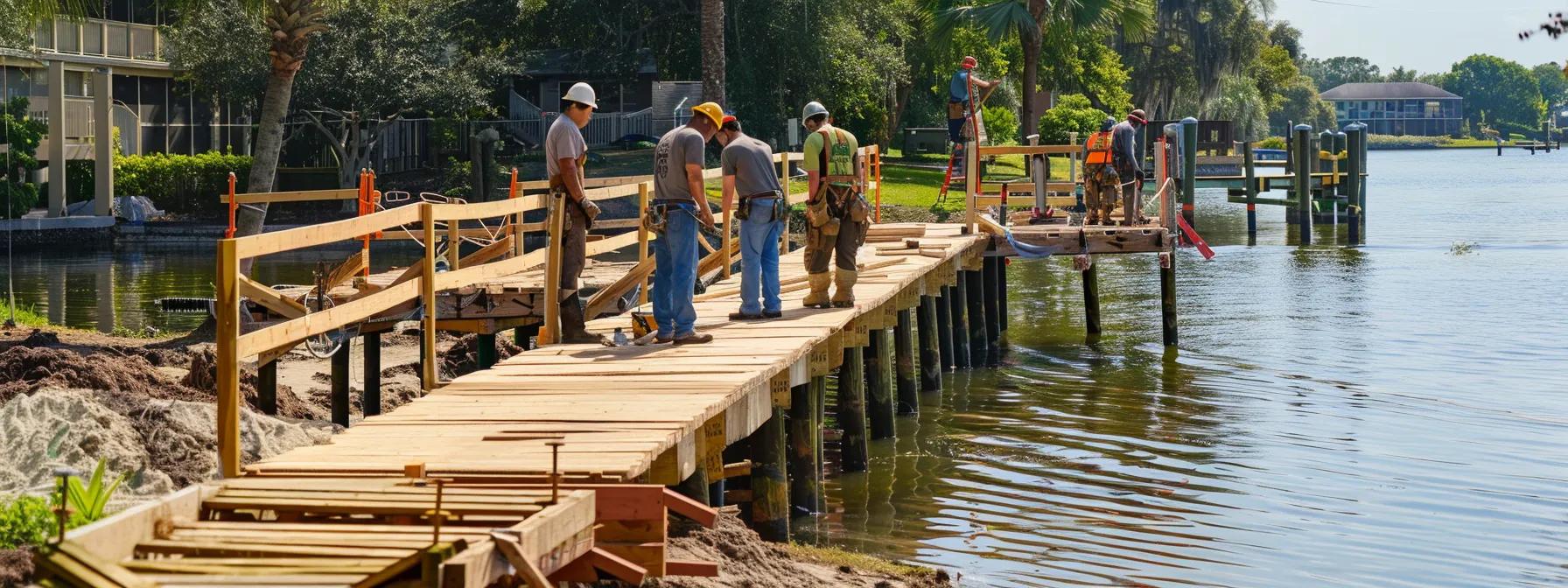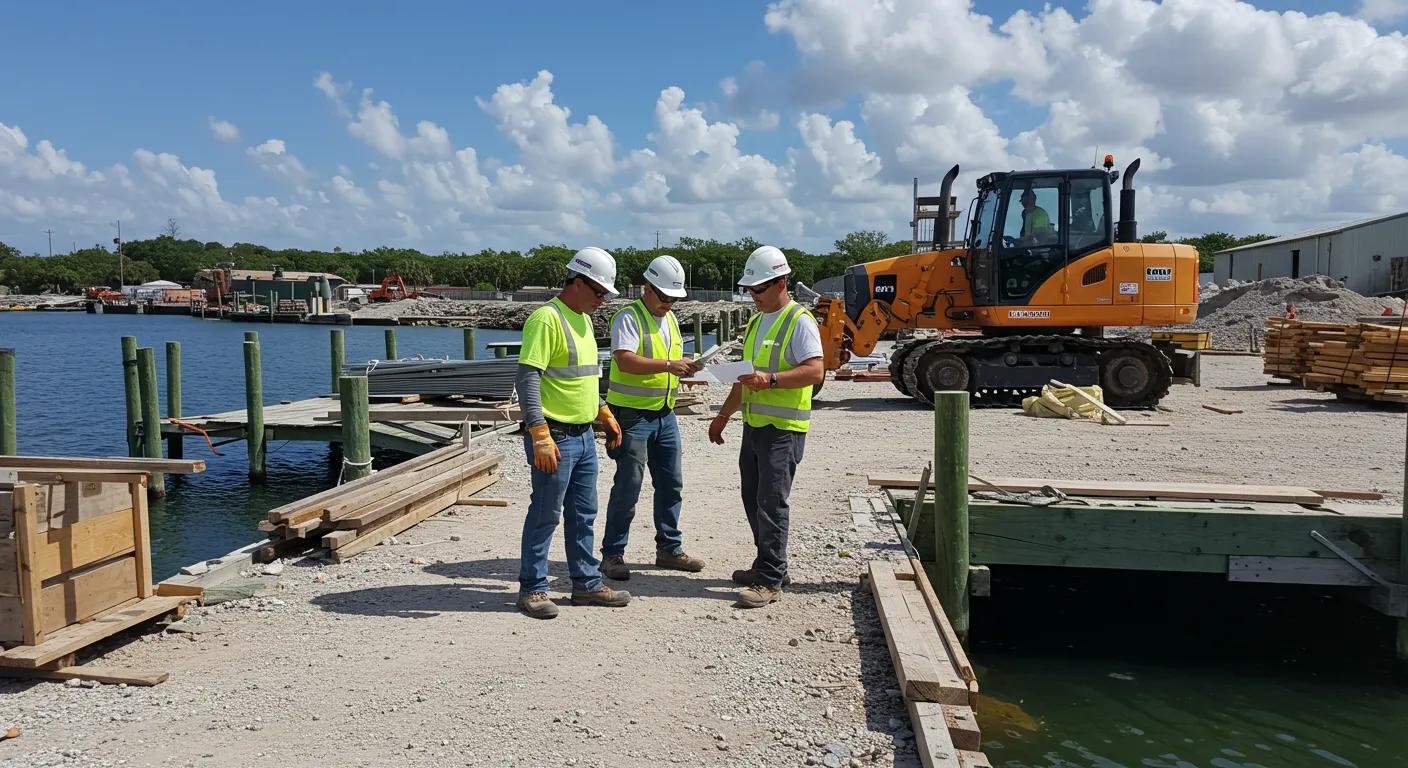Regulations for Building Your Residential Dock
Building a residential dock requires careful adherence to local, state, and federal rules along with environmental and safety guidelines. Homeowners must understand everything from zoning restrictions to specific structural requirements so that their dock remains both functional and fully compliant. This article outlines the necessary regulations, including permitting processes, environmental safeguards, design rules, and professional collaboration that ensure a safe, durable, and sustainable dock installation—and helps you avoid costly penalties or structural issues in the future.
Now, let’s explore the steps and rules to follow when planning and constructing your residential dock.
Understanding Key Regulations for Residential Dock Building
When building a residential dock, it is critical to understand the various regulations that affect its design, construction, and long-term use. These rules encompass legal, structural, environmental, and community standards to secure your project’s approval and ensure safety.
Identifying Applicable Local, State, and Federal Dock Rules
Dock construction is regulated through multiple frameworks. Local zoning laws define where docks can be built, while state building codes specify construction materials, load capacities, and structural integrity needed to endure environmental forces such as wave action and fluctuating water levels. Federal environmental guidelines (like those in the Clean Water Act and Clean Water Rule) protect water quality, aquatic habitats, and public access. Consulting with local planning departments and state regulatory bodies ensures your dock complies with all these layers—using approved materials such as pressure-treated lumber or marine-grade steel and adhering to proper methods when activities like dredging or filling are involved.
Common Zoning Restrictions for Home Docks
Most municipalities impose zoning restrictions that limit a dock’s footprint, height, and distance from property boundaries and navigable waterways. These restrictions ensure that privately built docks do not block public access or adversely affect neighboring properties. For example, docks are often required to be a set distance from the shoreline to protect natural vegetation and maintain water flow. In addition, accessory structures like boathouses must meet separate placement and size guidelines. Failing to follow these rules can result in fines, mandated removal, or expensive modifications.
Structural and Material Requirements in Dock Building Codes
Building codes require that docks be constructed with materials that withstand environmental stresses such as strong winds, wave action, and variable water levels. Inspection standards demand proper load distribution with corrosion-resistant elements like concrete, treated lumber, or marine-grade metals. Energy conservation and sustainability are also factors, as eco-friendly options (sustainably sourced wood, recycled composites) may be recommended. Adhering to these requirements minimizes inspection failures and optimizes both safety and longevity.
Waterway Navigation and Public Access Stipulations
It is essential that your dock design does not impede waterway navigation or restrict public access to natural bodies of water. Regulations require providing adequate clearance for boat traffic and may even call for markers—including buoys or lights—to signal navigational paths. These stipulations protect both recreational and commercial watercraft and maintain public rights to water access while preventing hazardous conditions.
The Role of Homeowners Associations in Dock Governance
Homeowners associations (HOAs) often impose additional guidelines related to aesthetic and functional design. These rules may specify color schemes, façade alignments, and material types to ensure consistency within a waterfront community. Reviewing your HOA covenant guidelines before construction and maintaining communication with HOA representatives can smooth the approval process and help avoid penalties.
The Permitting Process for Your Residential Dock Project
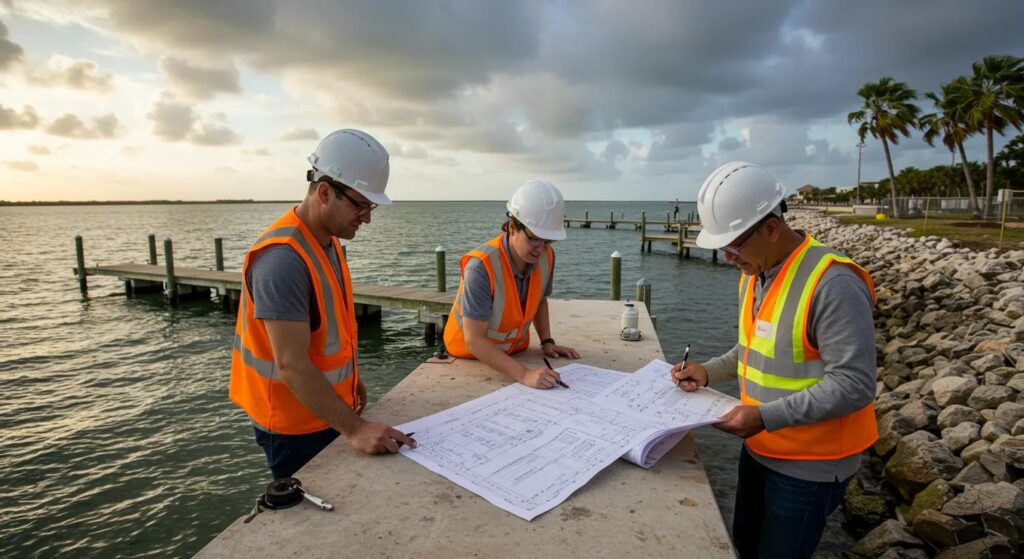
After understanding the applicable regulations, the next step is obtaining the necessary permits. Permits serve as your official approval to begin construction and confirm that all work complies with local, state, and federal rules.
Determining Which Dock Permits You Require
The specific permits needed depend on your dock’s type, size, and intended use. Typically, you will need a local building permit. In cases where the dock affects the shoreline—through dredging, for example—environmental permits from state or federal agencies may also be required. Consulting local zoning boards and legal advisors early helps compile a complete list of required documents.
Gathering Documentation for Your Permit Applications
Permit applications require detailed supporting documentation including construction plans, site surveys, engineering drawings, environmental impact assessments, and proof of ownership. Evidence regarding material quality, structural integrity, and measures to reduce environmental disruption should be compiled carefully. Well-organized paperwork speeds up the review process and reduces the risk of delays or rejections.
Submitting Applications to Relevant Authorities
After gathering documentation, submit your applications to the proper local, state, and sometimes federal agencies. Many authorities now use online portals for these submissions. Keeping records, such as submission receipts and communication logs, can help manage timelines and address any additional questions from inspectors efficiently.
Typical Timelines for Dock Permit Approval
Approval timelines vary with jurisdiction and project complexity. Local building permits generally require four to eight weeks of review, while permits involving environmental assessments may take several months. Regular communication with authorities can help manage expectations and adjust your construction schedule if delays occur.
Addressing Permit Denials or Requests for More Information
Permit denials or requests for extra details are not uncommon. Often, denials result from incomplete documentation, deviations from zoning standards, or environmental concerns. Establishing open dialogue with regulatory authorities and being prepared to revise your submission can help secure the necessary approvals without undue delay.
Upholding Environmental Safeguards During Dock Construction
Minimizing ecological impact during construction is essential. Environmental safeguards not only meet legal requirements but also sustain the natural beauty and health of your waterfront habitat.
Protecting Water Quality and Aquatic Habitats
Regulations are in place to ensure that dock construction does not contaminate water sources. Techniques such as using non-toxic sealants, integrating filtration systems, and proper erosion control are critical. Detailed water quality assessments help identify risks to aquatic habitats, which support fish, aquatic plants, and wildlife. By maintaining adequate distances from spawning grounds and sensitive vegetation areas, your construction complies with regulations and protects natural ecosystems.
Minimizing Shoreline Erosion and Disturbances
Erosion control measures—like installing riprap, using geotextile fabrics, and planting native vegetation—are mandated to stabilize shorelines. Engineering assessments can help plan appropriate setback distances and placement strategies, reducing sediment runoff and preventing long-term degradation of your property. These measures are essential when the dock’s design alters natural land contours.
Selecting Eco-Friendly Materials for Your Dock
Using environmentally friendly materials limits your dock’s ecological footprint. Instead of untreated wood that can deteriorate and pollute, many codes now encourage recycled composites, sustainably harvested lumber, or marine-grade metals. These materials lower the need for frequent repairs, thereby reducing maintenance costs and environmental risks such as creosote or chemical leaching.
Managing Construction Debris and Waste Responsibly
Proper waste management is crucial. Regulations require that all construction debris be segregated and disposed of properly—recycling where possible—to prevent waterway contamination. Contractors must submit waste management plans that detail how hazardous and recyclable materials will be handled, ensuring that no debris adversely affects the environment.
Understanding Rules for Dredging or Filling Activities
Dredging or filling operations can significantly affect water quality and marine life. Permits for these activities include criteria to reduce sediment suspension and ensure that fill materials are placed correctly. Detailed plans and environmental impact assessments must show that such operations will not compromise aquatic biodiversity or the natural balance of the water resource.
Design and Placement Rules for Your Home Dock
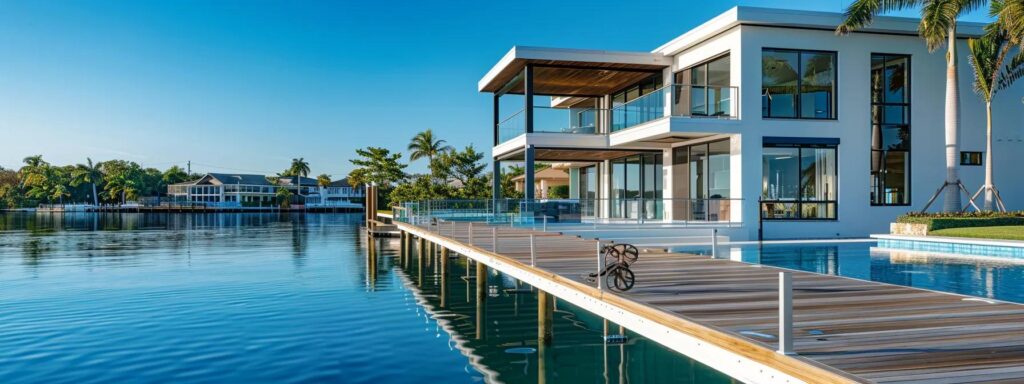
The design and placement of your dock must be planned to ensure safety, functionality, and long-term stability while harmonizing with the surrounding natural environment.
Adhering to Size and Dimension Limitations
Design regulations impose limits on maximum length, width, and height to prevent the dock from encroaching on navigable waters or obstructing public access. Clear dimension guidelines apply not just to the overall dock structure but also to elements like pilings and gangways. These constraints maintain aesthetic consistency, reduce structural failure risks, and preserve property values.
Setback Requirements From Property Lines and Channels
Setback rules determine how far the dock must be from property lines, navigational channels, and sensitive ecological areas. This buffer helps protect neighboring properties, ensures safe water flow, and minimizes interference with emergency services. A professional survey can accurately determine these boundaries to integrate them into your dock’s design.
Dock Configuration and Layout Guidelines
Efficient dock designs rely on proper configuration and layout. Detailed engineering drawings should illustrate how modular sections connect and distribute loads effectively. A well-planned layout takes into account optimal positioning for ladders, railings, and platforms to facilitate safe ingress and egress while providing ample mooring space for watercraft.
Lighting and Safety Feature Mandates
For safety, docks must be equipped with features like energy-efficient LED lighting, life rings, non-slip surfaces, and guardrails. Proper lighting enhances visibility in low-light conditions, while thoughtful placement of safety features limits hazards related to watercraft use, shifting water levels, and emergencies.
Accessibility Standards for Dock Design
Accessibility is fundamental. Designers should integrate ramps, handrails, and non-slip surfaces to create a barrier-free environment. These guidelines ensure that docks accommodate family members of all ages, elderly residents, and individuals with mobility challenges—helping to meet legal requirements and community standards.
Working With Professionals for Compliant Dock Installation
Partnering with qualified professionals is key to managing the many regulatory aspects of dock construction. Experienced experts streamline design, permit acquisition, and final inspections.
Selecting Qualified and Licensed Dock Builders
Choose a dock builder with a proven track record and the necessary licenses and certifications. Their familiarity with local environmental conditions, zoning restrictions, and building codes ensures that the dock is constructed with durability and safety in mind. Reviews and references from previous projects provide reassurance of quality workmanship.
Verifying Contractor Insurance and Credentials
Before hiring, confirm that your contractor carries adequate liability insurance and holds relevant certifications. This protects both parties in case of accidents or structural issues during construction. Verification with the issuing agency is recommended to ensure that the contractor meets industry standards.
Ensuring Your Builder Understands Residential Dock Building Regulations
A competent dock builder will be knowledgeable about local zoning laws, state codes, and federal environmental regulations. Their ability to explain and adapt to evolving regulatory requirements minimizes the risk of non-compliance. Continuous professional development in these areas is essential for long-term project success.
Contractual Agreements and Scope of Work Definition
A clearly written contract outlines all aspects of the project, including design details, materials, timelines, and responsibilities for permit applications. Legal review of the contract helps ensure that warranty, dispute resolution, and contingency plans are addressed. This document protects your investment and aligns expectations between you and the contractor.
The Significance of Final Inspections and Approvals
Final inspections by local and state authorities confirm that all construction elements meet regulatory standards. Preparing for these inspections by reviewing documentation, removing temporary structures, and verifying safety features ensures smooth approval and provides peace of mind that your dock is safe and compliant.
Post-Construction Obligations and Long-Term Compliance
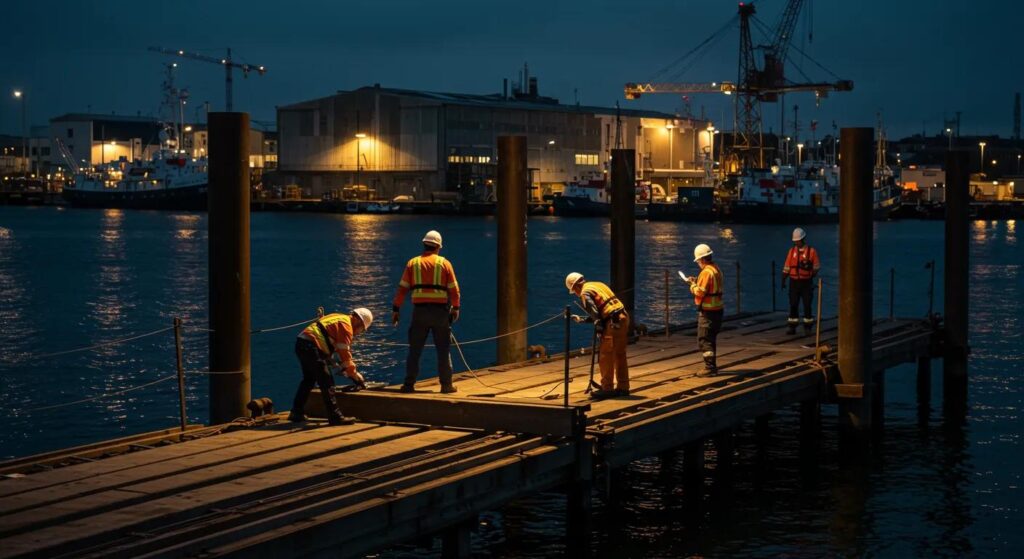
Building your dock is just the beginning. Ongoing compliance ensures that the dock remains safe, visually appealing, and functionally sound over time.
Ongoing Maintenance Requirements for Dock Safety
Regular maintenance—such as annual inspections, reapplication of protective coatings, and prompt repair of corrosion or decay—is essential to sustain your dock’s structural integrity. Many jurisdictions require periodic maintenance reports to confirm adherence to building codes. A proactive maintenance strategy can prevent accidents and reduce long-term repair costs.
Understanding Rules for Dock Modifications or Repairs
Over time, modifications or repairs may be necessary due to changing usage patterns or structural degradation. It is important to review your original permit conditions and consult local authorities to determine if additional permits are needed. Proper documentation of any changes helps maintain compliance and prevents issues during future inspections or permit renewals.
Permit Renewal Procedures if Applicable
Some jurisdictions require periodic renewal of permits. Renewal typically involves submitting updated documentation and fees, and sometimes undergoing brief inspections. Tracking permit expiration dates and initiating renewal applications early can help prevent fines or forced removal of the dock.
Consequences of Violating Dock Building Regulations
Non-compliance can result in fines, mandatory modifications, or even removal of the dock. Increased liability in case of accidents or environmental damage is an additional risk. It is essential to address any regulatory concerns promptly and maintain thorough documentation to mitigate these risks.
Staying Informed About Changes in Residential Dock Rules
Regulatory frameworks change as environmental, technological, and community standards evolve. Homeowners should subscribe to local governmental newsletters, join waterfront associations, and maintain communication with industry experts. Staying informed helps you adapt your dock if regulations evolve, ensuring long-term compliance and protection of your investment.
Frequently Asked Questions
Q: What local permits are typically required for residential dock construction? A: Permits generally include building permits, zoning clearances, and, in some cases, coastal or shoreline use permits. Check with your local planning department for specific requirements.
Q: How do environmental regulations affect my dock project? A: Regulations under the Clean Water Act and related laws require that dock construction does not harm water quality, aquatic habitats, or public access. This includes proper waste management and erosion control.
Q: Can I modify my dock after construction without additional permits? A: Modifications may require further permits, especially if changes affect the dock’s dimensions or adherence to original zoning and environmental rules. Always consult local authorities before making significant alterations.
Q: What are the consequences if my dock violates local building regulations? A: Violations can lead to fines, enforced structural modifications, or even complete removal. Non-compliance also increases liability in accidents or environmental damage.
Q: How do I ensure my dock remains accessible to everyone? A: Incorporate ramps, handrails, and non-slip surfaces to meet accessibility standards. This ensures safe use for all individuals and complies with legal requirements.
Q: What should I look for when selecting a dock builder? A: Choose a builder who is licensed, insured, and experienced with residential dock projects. Verify their credentials, review past projects, and ensure they understand local, state, and federal regulations.
Q: How often should my dock be inspected for maintenance purposes? A: Annual inspections are recommended, with additional checks after severe weather. Inspections help assess structural integrity, safety features, and compliance with current regulations.
Final Thoughts
Your residential dock project enhances waterfront property while requiring strict adherence to numerous regulations. Understanding legal and environmental requirements, navigating the permitting process, and working with qualified professionals ensures your dock is safe, durable, and sustainable. With thorough documentation and regular maintenance, your investment will continue to add value and safety to your property while remaining environmentally friendly.
| Regulation Aspect | Key Requirement | Benefit | Example/Standard |
|---|---|---|---|
| Local Zoning | Setback and dimensional limits | Prevents encroachment | Minimum setback from property line |
| Structural Codes | Use of corrosion-resistant materials | Ensures longevity and safety | Pressure-treated lumber or marine steel |
| Environmental Guidelines | Pollution control and erosion prevention | Protects aquatic habitats | Compliance with Clean Water Act |
| Permit Renewal | Timely submission of updated documents | Continuous legal compliance | Annual or biannual inspections |
| Safety Features | Installation of lighting and railings | Enhances user safety | LED lighting, non-slip surfaces |
Before finalizing your dock project, use the table above as a quick reference to verify that all regulatory aspects have been addressed. Regular reviews and adherence to these requirements are essential for a safe, compliant, and environmentally friendly dock installation.
| Material/Structural Feature | Regulation Requirement | Compliance Benefit | Example/Material Recommendation |
|---|---|---|---|
| Pilings and Fasteners | Must support expected loads | Structural integrity | Marine-grade bolts and fasteners |
| Decking Materials | Must be water and weather resistant | Long-lasting performance | Composite decking or treated wood |
| Safety Installations | Must include railings, lighting | Enhances overall safety | Handrails, LED lights, non-slip treatments |
| Eco-Friendly Choices | Encouraged for minimal environmental impact | Sustainable building practices | Recycled composites, sustainably sourced lumber |
| Inspection and Testing | Regular assessments by professionals | Ensures ongoing compliance | Annual professional inspections |
Before you begin construction, consult with local authorities and industry experts to ensure your project plan meets all necessary standards. This proactive approach can save time, money, and help prevent potential legal issues.

